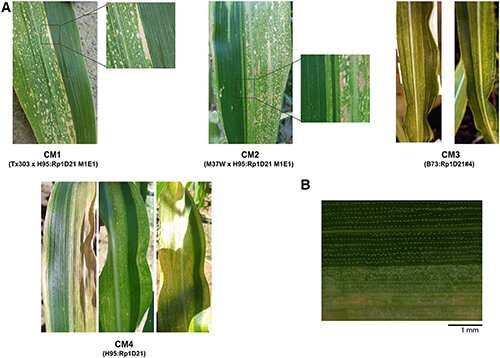Insight into the plant immune system

Found in almost every plant species, disease-resistance proteins (R proteins) are an important part of the plant immune system. Many R proteins trigger an extreme hypersensitive defense response when they recognize specific pathogens, which results in rapid host cell death in the area surrounding the pathogen infection. This recognition event can also trigger changes in gene expression and other physiological and biochemical responses. The combination of these responses can be very effective in fighting diseases.
To further explore this hypersensitive response, Shailesh Karre, Peter Balint-Kurti, and colleagues at Purdue University, North Carolina State University, and USDA Agricultural Research Service, generated chimeric maize leaves in which an auto-active R protein (Rp1-D21), which triggers a defense response without requiring a recognition event, was present in one part of the leaf and absent in the other.
"In these leaves we saw that cell death and chlorosis were present only in cells that carried the auto-active protein and that cells without the auto-active protein did not display these symptoms even if they directly bordered tissue that had the protein and were undergoing cell death," explained Balint-Kurti.
They also looked at the expression of hypersensitive response-related genes in both cell types and found that, unlike cell death, certain genes that were induced by the hypersensitive response were also induced in bordering cells without the auto-active resistance protein. Ultimately, they found that Rp1-D21 is cell-autonomous in regards to cell death but not in regards to the hypersensitive response.
"This informs some efforts to genetically engineer plants with R proteins," said Balint-Kurti. "For example, it tells us that, in some cases, it may not be sufficient to express R proteins only in certain parts of the plant."
More information: Shailesh Karre et al, Maize Plants Chimeric for an Autoactive Resistance Gene Display a Cell-Autonomous Hypersensitive Response but Non–Cell Autonomous Defense Signaling, Molecular Plant-Microbe Interactions (2021). DOI: 10.1094/MPMI-04-20-0091-R
Journal information: Molecular Plant-Microbe Interactions
Provided by American Phytopathological Society



















